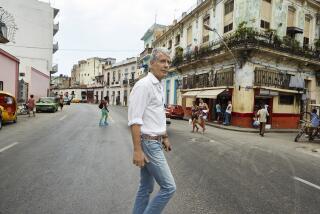Rudolf Arnheim, 102; visual theorist who wrote about art and perception
Rudolf Arnheim, a German-born psychologist and visual theorist whose writings influenced generations of thinkers about the relationship between art and perception, died June 9 at Glacier Hills retirement community in Ann Arbor, Mich. He was 102 and had pneumonia.
In his best-remembered books -- “Art and Visual Perception” (1954), “Film as Art” (1957) and “Visual Thinking” (1969) -- he applied gestalt theory, which analyzes how perception of the whole is greater than the sum of its interrelated parts. Among the “parts” he examined were the structures of an artwork’s forms and colors and the emotional reaction that results.
“I consider art to be a means of perception, a means of cognition,” he once said. “Perception makes it possible to structure reality and thus to attain knowledge. Art reveals to us the essence of things, the essence of our existence. That is its function.”
He had published hundreds of essays for the academic and popular press since he began working as film critic in 1920s Weimar Germany. At a time when films were judged mostly as disposable, popular entertainments, he insisted they could be compared favorably with the fine arts.
Arnheim admired the “artistic purity of expression” of silent film -- words, he said, “significantly limit the expression of the image.” Yet one of his more enduring essays, “The Film Critic of Tomorrow” (1935), satirized fellow critics bemoaning the end of the silent period.
Jim Hoberman, the chief film critic of the Village Voice in New York, said: “You couldn’t be nostalgic for what was no longer fact. It’s perfectly obvious to us now. But in context then, it was a powerful point in how the marketplace and technology will change things.”
A well-regarded 1998 Hoberman essay called “The Film Critic of Tomorrow, Today” used many of Arnheim’s arguments to critique modern reviewers who thought quality cinema had perished with the blockbuster adventure film. He said the original Arnheim essay remained fresh because there will always be people nostalgic for things that do not exist anymore.
Arnheim taught at the New School for Social Research in New York City and Sarah Lawrence College in Bronxville, N.Y., from the 1940s to 1960s. Later, he became a professor of the psychology of art at Harvard University and a visiting professor at the University of Michigan before his retirement in 1984.
Rudolf Julius Arnheim was born in Berlin on July 15, 1904. His father owned a piano factory.
At the University of Berlin, he received a doctorate in philosophy -- at the time, psychology was considered a branch of philosophy -- and studied with such gestalt theorists as Max Wertheimer and Wolfgang Kohler.
After graduation in 1928, he joined the staff of the left-leaning culture journal Die Weltbuehne and covered music, architecture and cinema.
With the Nazis’ rise to power in 1933, Die Weltbuehne became a major target of the fascists. Arnheim said he was particularly fearful because he had satirized Hitler in an essay for a Berlin newspaper.
Arnheim went to Rome, where he spent five years as associate editor of a League of Nations cultural publication. He enhanced his reputation by writing books about film and radio as art forms.
He was forced to leave Italy in 1938 when Benito Mussolini instituted race laws targeting Jews.
Arnheim immigrated to New York and won a grant from the Rockefeller Foundation to study the influence of radio soap opera on listeners. He became a naturalized citizen in 1946.
His first major U.S. book was “Art and Visual Perception,” which was translated into 14 languages over the years.
In later studies, he explored topics as varied as children’s visual perception abilities, conceptual art (“useful exercises of the imagination”) and Pablo Picasso’s Spanish Civil War painting “Guernica.”
Survivors include a stepdaughter whom he adopted, Margaret Nettinga of Heemstede, the Netherlands; two grandchildren; and a great-granddaughter.
More to Read
Sign up for our Book Club newsletter
Get the latest news, events and more from the Los Angeles Times Book Club, and help us get L.A. reading and talking.
You may occasionally receive promotional content from the Los Angeles Times.






